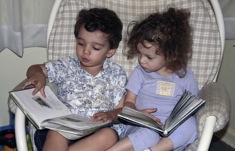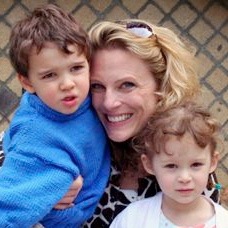It’s fascinating as a mom to have the luxury of enough time to pay attention to the different ways my kids read. It helps me understand their process, find books that will appeal to them, and I hope understand them more and be a better mother to them. But my twin children Molly and Jacob also have taught me something that has purely and selfishly benefited me as a reader. I am reminded to read slower and find the narrative that speaks to me at that moment in time — in their books, in my books, and in life in general.
By age 2 ½ Molly and Jacob had grown by leaps and bounds in their literacy. Watching how they “read” books to me as toddlers gave me the time to ponder their development and see three distinct types of reading begin to unfold:
1. Memorization. This is where they would memorize a book, and recite it back to me from memory. Verbatim, page by page. Jacob often did this the way I said the Gettysburg Address when I memorized it in fourth grade (or the way Claire Danes said her lines in Romeo and Juliet) — quickly, by rote, and clearly without thinking about the meaning at all. He could get through a long book — a favorite was David Shannon’s Too Many Toys
— in under two minutes without either inflection or missing a word. This was a surprise to me, because I didn’t know children were capable of such intense memorization at such a young age.
2. Following the author’s narrative. They would often tell me the story of the book, following along with the pictures, but without using the same words as the author. Molly’s favorite two books to do this with were Miss Spider's Tea Party, and Go, Dog. Go!
. She loved to talk about when Miss Spider is crying, and when she’s not crying anymore because “her friends came over.” In Go, Dog. Go!
, she loved to tell me the color and size of each dog, what they’re doing, and what they’re not doing. The thing that managed to surprise me with this type of reading was to see how much life, inflection, and expression she could put into pointing out that someone was sad, then making up a back story for why, and finally explaining when they would be happy again. It’s so charming (though it really isn’t surprising from my resident drama queen!).
3. Following their own narrative. This kind of reading is my absolute favorite — they look at the pictures, but the story they derive and tell has nothing to do with the author’s narrative. Often we would read Where the Wild Things Are and simply look for when you can see Max’s buttons and when you can’t. Or we would find all the pages where he’s carrying his scepter, versus the pages where he must have put it down. Or we might count how many of something there are on a page. Or find one little thing, like a bowl of fruit on the table, and that might turn into a story about going to the Farmer’s Market to pick out fruit, and what kinds of fruit are their favorites.
The next time you read a story to your child, let them lead the way. It’s second nature to us to teach, to correct our children, and show them the “right” way to do things — whether it’s reading books from right to left, wanting to read straight through without going backwards, not wanting to skip pages, or turn a page before we’re done. But put that all away. Sit on your hands if you need to, and let them turn the pages. Let them ask every question they want, and rather than answer them, play psychologist and turn the question back to them to answer. (“Why do you think the Mommy bunny turned into the wind?”) Turn it into a game — how far can your exploration take you? How long can you “read” and discuss one book?
Let one question lead to another and see where your conversation, where that narrative, leads. Then when you’ve finished the book, hand it to your child and ask them to tell you the story. It’s eye-opening to see what they’re getting from each reading, compared with what we suppose they’re getting.
This essay is an excerpt from Home Is Where the Books Are.



